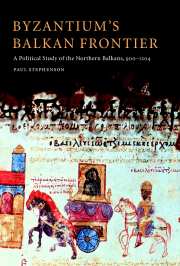Book contents
- Frontmatter
- Contents
- List of maps and figures
- Preface
- A note on citation and transliteration
- List of abbreviations
- Introduction
- 1 Bulgaria and beyond: the Northern Balkans (c.900–963)
- 2 The Byzantine occupation of Bulgaria (963–1025)
- 3 Northern nomads (1025–1100)
- 4 Southern Slavs (1025–1100)
- 5 The rise of the west, I: Normans and Crusaders (1081–1118)
- 6 The rise of the west, II: Hungarians and Venetians (1100–1143)
- 7 Manuel I Comnenus confronts the West (1143–1156)
- 8 Advancing the frontier: the annexation of Sirmium and Dalmatia (1156–1180)
- 9 Casting off the ‘Byzantine Yoke’ (1180–1204)
- Conclusions
- Bibliography
- Index
2 - The Byzantine occupation of Bulgaria (963–1025)
Published online by Cambridge University Press: 25 August 2009
- Frontmatter
- Contents
- List of maps and figures
- Preface
- A note on citation and transliteration
- List of abbreviations
- Introduction
- 1 Bulgaria and beyond: the Northern Balkans (c.900–963)
- 2 The Byzantine occupation of Bulgaria (963–1025)
- 3 Northern nomads (1025–1100)
- 4 Southern Slavs (1025–1100)
- 5 The rise of the west, I: Normans and Crusaders (1081–1118)
- 6 The rise of the west, II: Hungarians and Venetians (1100–1143)
- 7 Manuel I Comnenus confronts the West (1143–1156)
- 8 Advancing the frontier: the annexation of Sirmium and Dalmatia (1156–1180)
- 9 Casting off the ‘Byzantine Yoke’ (1180–1204)
- Conclusions
- Bibliography
- Index
Summary
The status quo that prevailed between Byzantium and Bulgaria in the Period 927–59 was based on a mutual desire to ensure continued stability in each empire, and to eliminate the nomad threat to both. The arrangement was underpinned by the marriage alliance of 927, where the emperor undertook to recognize the tsar's imperial status, and to continue annual tribute payments. In return the tsar promised to defend the Byzantine empire's Balkan lands. Tribute payments continued to be paid until the death of Tsarina Maria Lecapena, some time in 963. However, through this period the Byzantine emperor had subtly altered his attitude to the Bulgarian tsar, and the tsar had acquiesced in this. During the same period the Byzantine emperor had significantly improved his contacts with the various peoples settled beyond Bulgaria. The increased frequency of Magyar raids had alarmed the Byzantines, and a series of arrangements were made with powerful Magyar chieftains over and above the Bulgarian accord. To stabilize the situation in the lands immediately bordering the Danube trade was encouraged, Byzantine coins and jewellery made available, and salt from the Transylvanian mines purchased. A similar system for distributing goods had long been established to deal with the Pechenegs around Cherson. New contacts with the Rus of Kiev sought to exploit the northern peoples' greed for precious goods and metals. Slaves and the products of the Russian forest belt were brought to Constantinople annually according to stipulations laid down in increasingly detailed agreements.
- Type
- Chapter
- Information
- Byzantium's Balkan FrontierA Political Study of the Northern Balkans, 900–1204, pp. 47 - 79Publisher: Cambridge University PressPrint publication year: 2000



